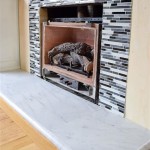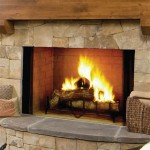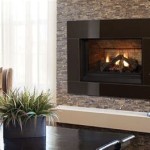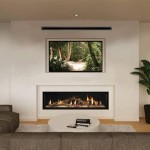Painting Your Fireplace Insert: A Comprehensive Guide
Fireplace inserts, designed to improve the efficiency and aesthetic appeal of existing fireplaces, often require maintenance and occasional cosmetic updates. Painting a fireplace insert is a relatively straightforward project that can significantly enhance its visual appeal and extend its lifespan. However, proper preparation and the selection of suitable materials are crucial for achieving a durable and attractive finish. This article provides a detailed guide to painting a fireplace insert, covering everything from safety precautions to optimal paint selection and application techniques.
Before embarking on this project, it's essential to understand the unique characteristics of fireplace inserts. These units are subjected to high temperatures and require paints specifically formulated to withstand such conditions. Using the wrong type of paint can lead to cracking, peeling, and the release of harmful fumes. Therefore, careful consideration must be given to every stage of the painting process.
Understanding the Need for High-Temperature Paint
The primary reason for using specialized paint on a fireplace insert is heat resistance. Standard paints are not designed to withstand the elevated temperatures generated by a burning fire. When exposed to heat, these paints will often blister, flake, and emit unpleasant odors, potentially releasing volatile organic compounds (VOCs) into the air. High-temperature paints, conversely, are formulated with resins and pigments that maintain their integrity even at temperatures reaching 1200°F or higher, depending on the specific product.
These specialized paints also offer superior adhesion to metal surfaces, which is particularly important for fireplace inserts. The expansion and contraction of metal due to temperature fluctuations can cause standard paints to lose their grip, leading to premature failure. High-temperature paints are designed to flex with the metal, minimizing the risk of cracking and peeling.
Furthermore, many high-temperature paints are designed to resist rust and corrosion. Fireplace inserts are often exposed to moisture and condensation, especially during periods of disuse. Rust can compromise the structural integrity of the insert and detract from its appearance. High-temperature paints provide a protective barrier against these elements, extending the lifespan of the insert.
Preparing the Fireplace Insert for Painting
Thorough preparation is paramount to achieving a successful and long-lasting paint job. This process involves several steps, each contributing to the overall quality of the final finish. Neglecting any of these steps can significantly reduce the lifespan and aesthetic appeal of the painted surface.
The first step is to ensure the fireplace insert is completely cool. Attempting to work on a hot surface is not only dangerous but will also prevent the paint from adhering properly. Allow the insert to cool for at least 24 hours after the last fire before beginning any preparation.
Next, the insert must be thoroughly cleaned to remove any soot, ash, grease, or other contaminants. A wire brush or scraper can be used to remove loose debris. Follow this with a thorough cleaning using a specialized fireplace cleaner or a solution of trisodium phosphate (TSP). Always wear appropriate personal protective equipment (PPE), such as gloves and eye protection, when working with cleaning chemicals.
After cleaning, rinse the insert thoroughly with clean water and allow it to dry completely. Any remaining residue can interfere with paint adhesion. Once dry, inspect the surface for any rust or corrosion. Use a wire brush or sandpaper to remove rust thoroughly. For heavily rusted areas, a rust converter can be applied to neutralize the rust and prepare the surface for painting. Follow the manufacturer's instructions for application and drying times.
Mask off any areas that should not be painted, such as glass doors or decorative elements. Use painter's tape and plastic sheeting to protect these areas from overspray. Proper masking ensures a clean and professional finish.
Finally, lightly sand the entire surface to be painted. This creates a slightly roughened surface that will improve paint adhesion. Use fine-grit sandpaper (220-grit or higher) and sand in a circular motion. After sanding, wipe down the surface with a tack cloth to remove any sanding dust.
Selecting and Applying High-Temperature Paint
Choosing the right type of high-temperature paint is crucial for the success of the project. Several types of high-temperature paints are available, each with its own advantages and disadvantages. Consider the specific needs of the fireplace insert and the desired finish when making a selection.
Aerosol spray paints are a popular choice for fireplace inserts due to their ease of application and relatively quick drying times. These paints are available in a variety of colors and finishes, including matte, satin, and gloss. When using aerosol spray paint, apply thin, even coats to avoid drips and runs. Hold the can approximately 10-12 inches from the surface and move it in a smooth, consistent motion. Allow each coat to dry completely before applying the next.
Brush-on high-temperature paints are another option. While they require more effort to apply, they often provide a thicker and more durable finish. Brush-on paints are particularly useful for covering intricate details or for touching up small areas. Use a high-quality brush specifically designed for use with high-temperature paints. Apply the paint in thin, even coats, avoiding thick areas that can lead to drips and runs.
Before applying any paint, it is recommended to apply a high-temperature primer. Primer improves paint adhesion and provides a uniform surface for the topcoat. Choose a primer specifically formulated for use with high-temperature paints. Apply the primer in the same manner as the topcoat, following the manufacturer's instructions for application and drying times.
When painting, work in a well-ventilated area. High-temperature paints can emit fumes, so it is important to ensure adequate ventilation to avoid inhaling harmful vapors. Wear a respirator or dust mask to protect your lungs. Avoid painting in direct sunlight or during periods of high humidity, as these conditions can affect the drying time and the quality of the finish.
After applying the final coat of paint, allow it to dry completely according to the manufacturer's instructions. This may take several hours or even days, depending on the type of paint and the ambient temperature and humidity. Once the paint is fully dry, carefully remove the masking tape and plastic sheeting.
To cure the paint properly, it is often recommended to gradually increase the temperature of the fireplace insert over several days. This can be achieved by burning small fires initially and gradually increasing the size and duration of the fires. This curing process helps the paint to fully harden and bond to the metal surface, maximizing its durability and heat resistance. Follow the manufacturer's recommendations for curing the paint.
Finally, inspect the painted surface for any imperfections, such as drips, runs, or uneven areas. Touch up any imperfections with a small brush or aerosol spray paint. With proper preparation and application, a painted fireplace insert can enhance the beauty and functionality of the fireplace for years to come.

How To Spray Paint A Brass Fireplace Insert Erfly House

How To Spray Paint A Brass Fireplace Insert Erfly House

How To Spray Paint A Brass Fireplace Insert Erfly House

How To Spray Paint A Brass Fireplace Insert Erfly House

Diy Fireplace Makeover With High Heat Paint Jessica Welling Interiors

How To Spray Paint A Brass Fireplace Bright Green Door

How To Spray Paint A Brass Fireplace Insert Inserts Glass

How To Paint Metal Fireplace Surround Four Generations One Roof

Fireplace Door Update With Spray Paint Roots Wings Furniture Llc

How To Prep Prime And Paint A Brick Fireplace Young House Love








